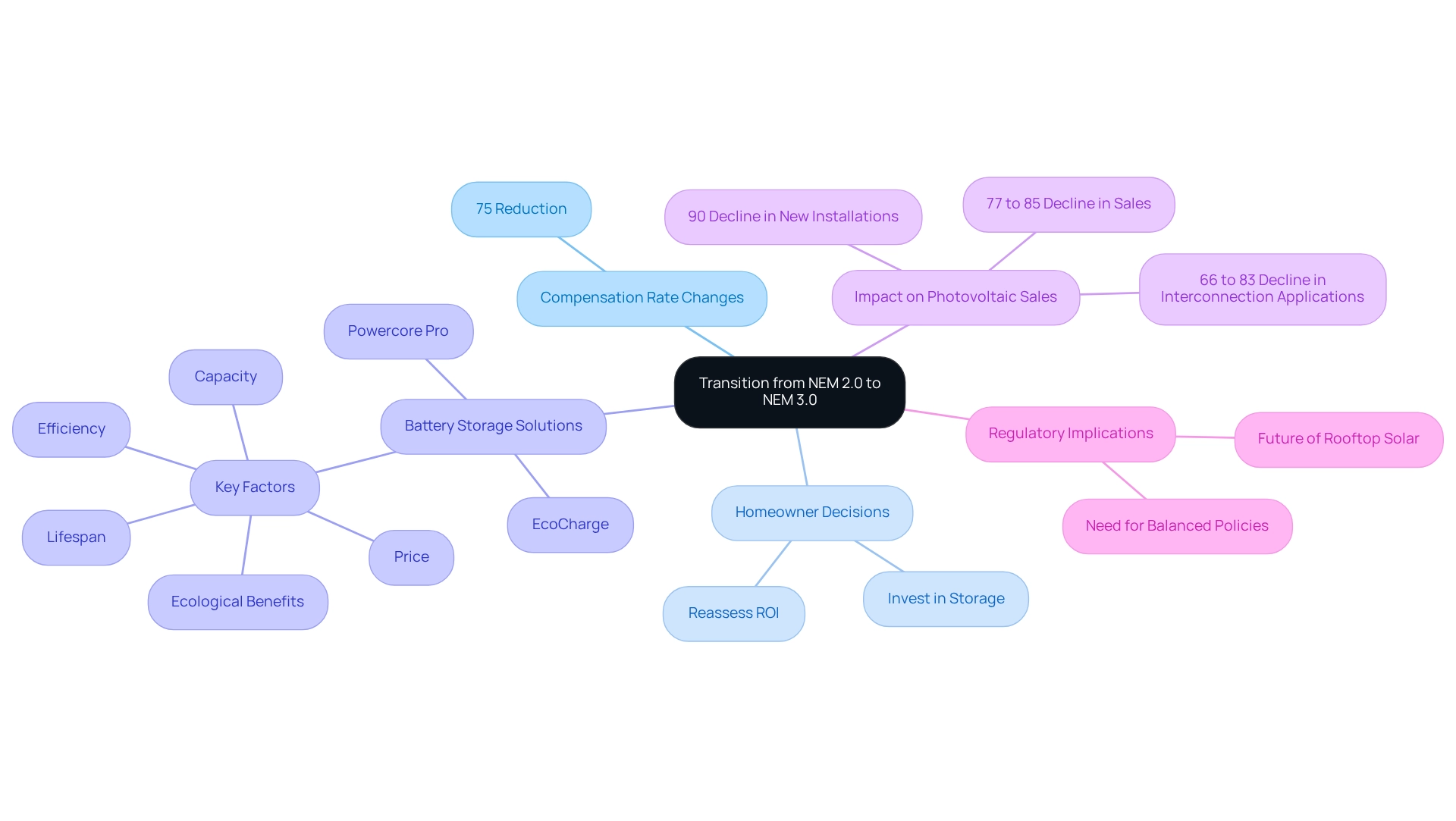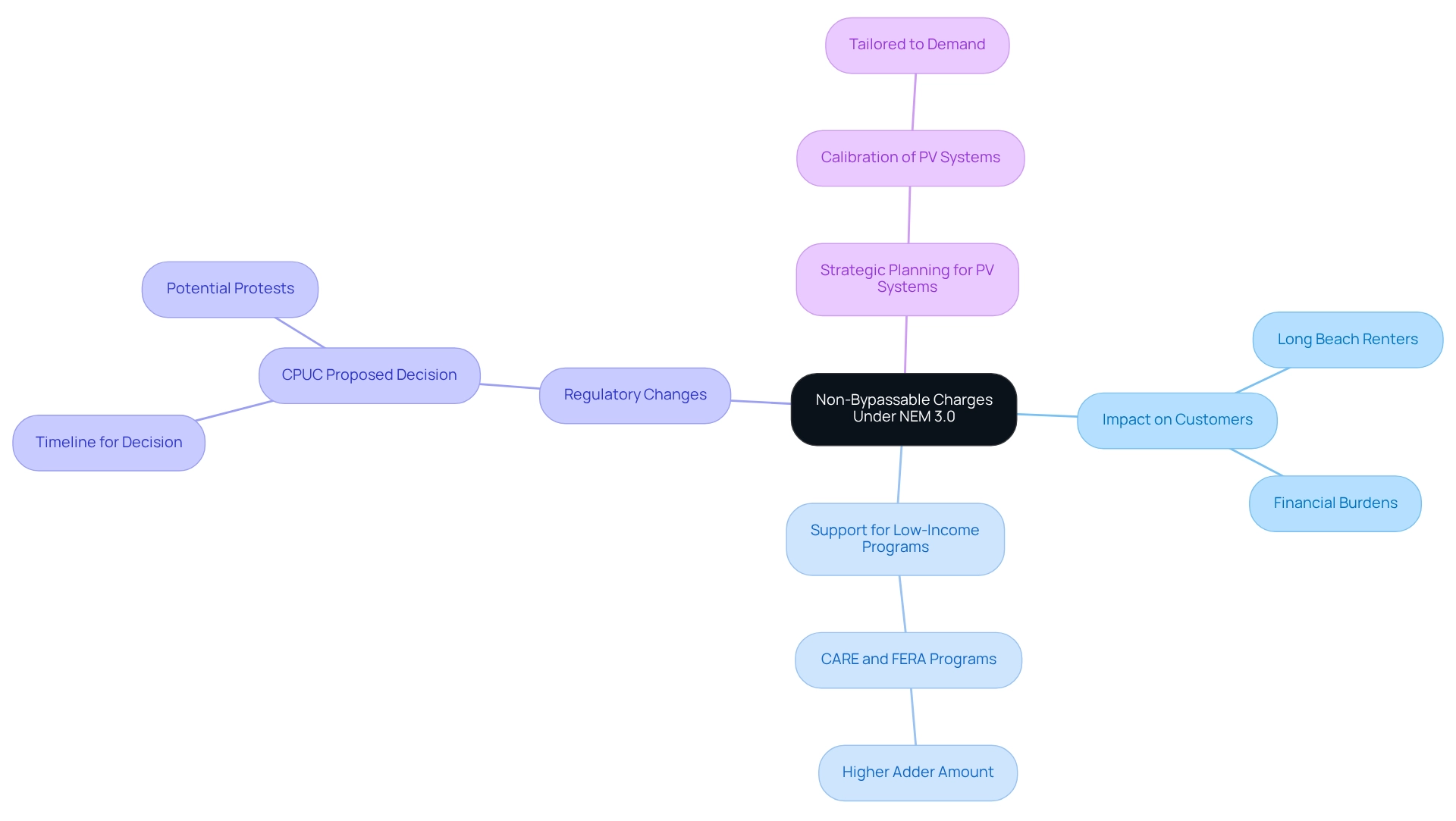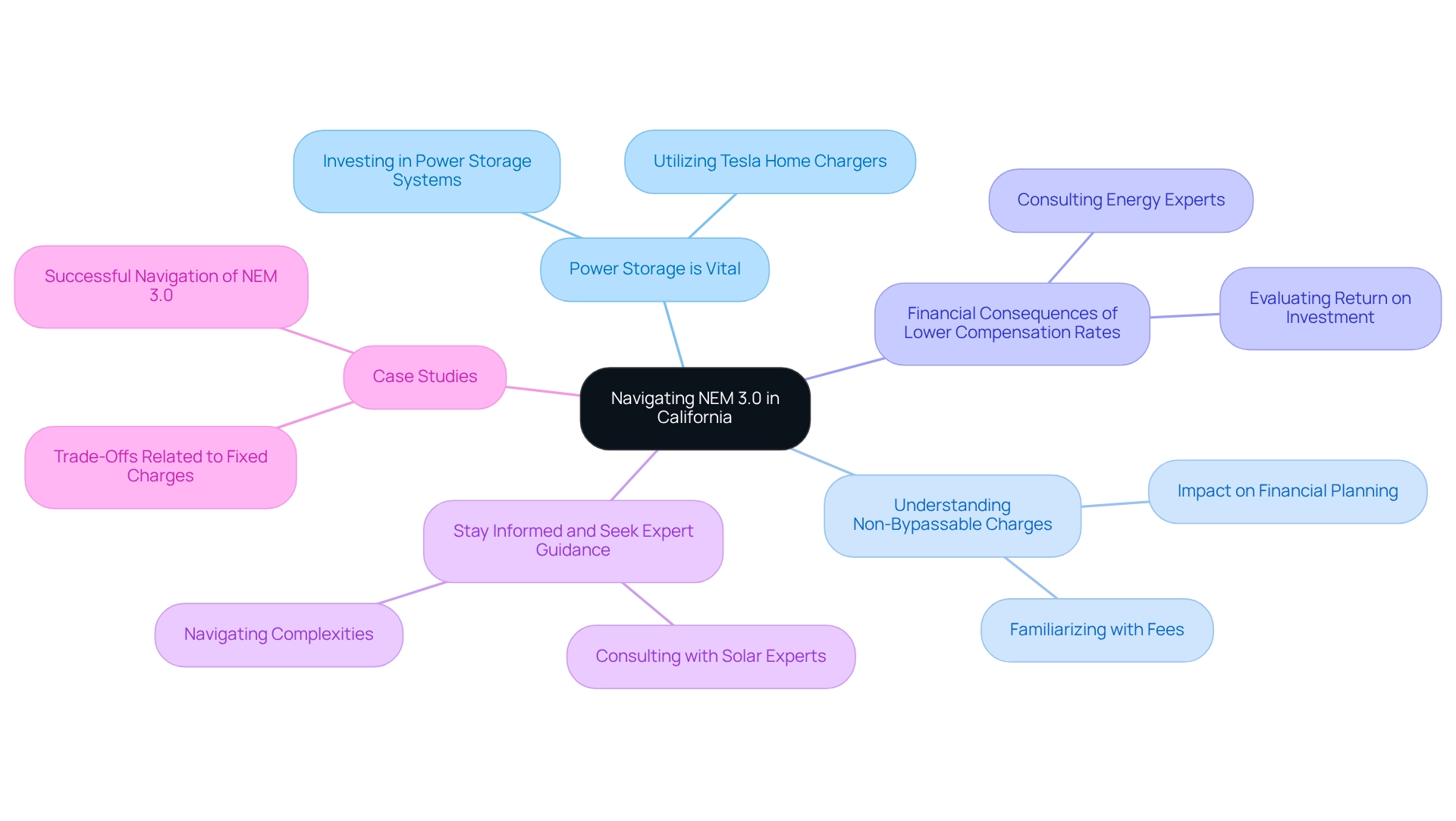Overview
In California, the implications of Net Energy Metering (NEM) 3.0 are significant for homeowners who are transitioning to renewable energy systems. We understand that concerns about rising energy bills can be overwhelming, and it’s common to feel uncertain about the changes ahead.
While it’s true that compensation rates for surplus power have decreased, investing in energy storage solutions is more crucial than ever. This investment not only maximizes savings but also fosters energy independence, allowing you to take control of your energy future.
Expert insights and real-world examples of homeowners adapting to these changes demonstrate that with the right strategies, you can thrive in this new landscape. Together, we can navigate these shifts and embrace a more sustainable future.
Introduction
In California, many homeowners are understandably concerned about the rising costs of energy bills. The landscape of solar energy is undergoing a significant transformation, especially with the introduction of Net Energy Metering (NEM) 3.0. This new framework not only adjusts compensation rates for excess energy fed back into the grid but also highlights the essential role of energy storage solutions for homeowners.
As the state pushes towards a sustainable future, it’s crucial for homeowners to grasp the implications of NEM 3.0 to maximize their investments in solar technology. With utility costs on the rise and regulations evolving, the choices made today will significantly shape the financial viability and energy independence of households across California. Together, we can navigate these changes effectively.
As this article delves into the intricacies of NEM 3.0, it will explore the challenges and opportunities that lie ahead for solar energy users, providing insights on how to approach this changing energy landscape with confidence and support.
What is Net Energy Metering (NEM) and Why is it Important in California?
Net Power Metering (NPM) serves as a vital billing system for residents with photovoltaic systems in California, allowing them to earn credits for the excess electricity they produce and contribute back to the grid. This system is particularly important in a state that prioritizes renewable resources and strives to significantly reduce greenhouse gas emissions. By utilizing these credits, homeowners can effectively lower their electricity expenses, making renewable energy not only an eco-friendly choice but also a financially sound investment.
The benefits of NPM extend beyond personal savings; they play a crucial role in promoting the widespread adoption of photovoltaic technology across California. As of 2023, the average residential electricity rate in the City of Santa Clara is 14.75 cents per kilowatt-hour (kWh), underscoring the potential savings for homeowners who embrace renewable sources. Moreover, large-scale photovoltaic projects, such as the Aquamarine project in Lemoore, which boasts a capacity of 325 MW and can power over 90,000 households, exemplify the growing reliance on renewable sources to meet California’s energy needs.
This project demonstrates how NEM can help reduce utility costs by increasing the amount of renewable energy fed back into the grid.
Powercore Electric offers tailored photovoltaic solutions, featuring high-efficiency panels designed for optimal performance even on cloudy days, storage options to enhance energy independence, and comprehensive roofing enhancements to protect your home. These services empower homeowners to maximize their investment in renewable energy, ensuring they benefit from both reduced utility costs and greater energy independence.
However, the ongoing dialogue surrounding rooftop panels and utility expenses indicates an urgent need to reassess California’s energy policies. Concerns have been raised that current regulations may impede the growth of solar energy utilization, which is essential for achieving the state’s renewable energy goals. A case study titled ‘The Future of Rooftop Photovoltaics in California’ reveals a strong consensus among experts that without supportive policies, the potential for rooftop photovoltaics to make a significant impact on California’s energy landscape could be jeopardized.
Severin Borenstein, a professor at the Haas School of Business, emphasizes that “the economics of renewable sources and the policies that support them are essential for ensuring that residents can benefit from solar energy.”
In 2025, the importance of NPM remains paramount, as it not only encourages residents to transition to renewable sources but also aligns with California’s broader environmental objectives. Expert opinions underscore that the concept of NPM is crucial for fostering a sustainable energy future, ensuring that homeowners can enjoy the dual benefits of reduced costs and increased energy independence. To learn more about how Powercore Electric can assist you in transitioning to renewable resources and reaping the benefits, reach out to us today.
Transitioning from NEM 2.0 to NEM 3.0: Key Changes and Implications
The transition from NEM 2.0 to NEM 3.0, effective April 15, 2023, marks a significant change in the nem cali compensation framework for solar power, and we understand that this can raise concerns for homeowners. Under the new NEM 3.0 framework, compensation rates for surplus power exported back to the grid have been reduced by approximately 75%. This substantial decrease is intended to encourage property owners to invest in storage solutions, as the financial feasibility of solar-only systems has been notably diminished.
As a result, homeowners are now faced with important decisions regarding their energy investments. The lowered compensation rates necessitate a reassessment of the return on investment for installations, prompting many to consider pairing their systems with battery storage to maximize the benefits of their power production. Key factors to consider when choosing a battery for renewable energy include capacity, efficiency, lifespan, price, and ecological benefits.
Powercore Electric offers a variety of premium batteries, including the Powercore Pro and EcoCharge models, designed to meet diverse needs while promoting sustainability. This strategic shift is vital for maintaining energy independence and ensuring residents can effectively manage their energy costs amidst the new policies.
The implications of nem cali extend beyond individual homeowners; they resonate throughout the energy sector. For instance, California has witnessed a staggering decline in photovoltaic sales, with reports indicating a drop of between 77% and 85% annually. Furthermore, interconnection applications have declined by 66% to 83%, compelling dealers and installers to adjust their offerings to include energy storage solutions that align with current incentives.
Significantly, there has been a 90% decline in new energy installations due to changes in net metering policies, underscoring the dramatic impact of these regulatory shifts on nem cali.
Real-life examples illustrate how homeowners are adapting to these changes. Many are opting to incorporate battery storage systems alongside their photovoltaic panels, allowing them to retain surplus power produced during peak sunlight hours for use during high-demand periods or outages. This adjustment not only enhances power reliability but also mitigates the financial impact of the new compensation rates, highlighting the importance of nem cali for ensuring dependable electricity during power outages and adverse weather conditions.
Testimonials from Powercore Electric clients reveal that those who invested in battery storage have realized significant savings on their utility bills and improved power security.
The ongoing discussion surrounding the future of rooftop installations in California emphasizes the need for regulations that balance utility profits with the benefits of decentralized power generation. As illustrated in the case study titled “The Future of Rooftop Energy in California,” this conversation highlights the necessity for policies that foster the growth of rooftop energy while ensuring utilities can maintain essential infrastructure without imposing excessive costs on consumers. As industry leaders, including Ross Williams, express their concerns about the drastic shifts in sales, it becomes increasingly clear that the transition to nem cali requires a collaborative approach to ensure that both consumers and utilities can thrive in this evolving energy landscape.
Understanding Non-Bypassable Charges Under NEM 3.0
Under NEM 3.0, non-bypassable charges (NBCs) are a significant concern for energy customers in California, including Long Beach renters. These charges are mandatory for all renewable customers, regardless of their power generation, and are designed to support public purpose initiatives and cover essential expenses related to grid maintenance. Importantly, these fees cannot be offset by renewable credits, meaning homeowners will incur these costs even if their systems generate enough power to meet their consumption needs.
We understand that navigating these non-bypassable fees can be daunting, especially when evaluating the financial benefits of renewable energy. While photovoltaic installations can lead to substantial reductions in overall utility bills, the impact of NBCs can diminish these savings. For instance, recent statistics show that low-income customers enrolled in CARE and FERA programs receive a higher adder amount, which may help alleviate some of the financial burdens associated with these charges.
This higher adder is crucial as it offers additional support to those who may be more vulnerable to the financial pressures imposed by NBCs.
For Long Beach tenants, exploring power options like Tesla home chargers and government initiatives can enhance their efficiency and sustainability. The implications of NBCs extend beyond individual households; they significantly influence the renewable energy market in California. As the California Public Utilities Commission (CPUC) prepares to unveil a Proposed Decision regarding NEM 3.0, stakeholders are eagerly awaiting clarity on how these charges will evolve.
The upcoming decision is expected to impact the adoption of renewable solutions statewide, with potential protests, or nem cali, that may delay implementation. The timeline suggests that stakeholders will gain insights into the new tariff structure by the end of the year, which will be vital for understanding the future landscape of renewable energy in California.
Expert opinions stress the importance of accurately calibrating PV systems to maximize their effectiveness, particularly in light of these charges. As Farzan Kazemifar notes, “Maximizing the effectiveness of photovoltaic projects requires accurate calibration of the photovoltaic system size, customized to the facility’s hourly electricity requirement and expected demand variations.” This underscores the need for strategic planning for property owners aiming to optimize their solar investments amidst the complexities introduced by non-bypassable charges.
In summary, a thorough understanding of non-bypassable charges under NEM 3.0 is essential for California residents, including Long Beach renters, particularly regarding NEM Cali. It not only affects individual savings but also has broader implications for the state’s renewable resource landscape, especially given the inefficiencies in the current utility pricing structure that challenge the adoption of renewable solutions. Together, we can navigate these challenges, and Powercore Electric is dedicated to assisting property owners in reaping the benefits of renewable energy.
Impact of NEM 3.0 on Solar Installations and Homeowners’ Choices
The launch of NEM 3.0 has understandably prompted many property owners to reconsider their investments in nem cali. As the payment for surplus power returned to the grid decreases, it’s common to feel uncertain about the size and layout of photovoltaic systems. This shift has led to a heightened focus on power storage solutions, allowing homeowners to optimize their savings by using stored power during peak demand periods.
In light of these changes, there’s a growing trend toward combining battery storage with photovoltaic systems. This combination not only enhances power independence but also provides a safety net against rising utility costs.
Powercore Electric, a trusted partner in the California community for over 30 years, emphasizes the importance of having a photovoltaic system tailored to your unique home and electricity needs. This commitment to a customer-first approach resonates with findings from case studies that highlight the value of informed decision-making through proper system design and installation. Homeowners who have customized their energy solutions, including storage options, often report greater satisfaction and financial benefits, reinforcing the quality craftsmanship that Powercore Electric is renowned for.
Expert insights from Severin Borenstein shed light on the evolving landscape of energy investments. He notes that the implications of NEM 3.0 and nem cali require careful consideration of long-term benefits. However, it’s essential to recognize that this transition may lead to a potential decline in new renewable energy installations unless property owners can clearly identify these advantages. Client testimonials further underscore the positive experiences with Powercore Electric’s skilled installers, praising the ease of installation, cost savings, and excellent communication.
Furthermore, ongoing discussions about climate change mitigation versus financial returns highlight the incentives that drive photovoltaic installations. This enriches the conversation surrounding homeowner decisions post-nem cali. We encourage homeowners to consult with Powercore Electric’s qualified installers to ensure they receive high-quality solutions that maximize their savings and align with their energy goals. Together, we can navigate these changes and work towards a more sustainable future.
Financial Implications of NEM 3.0: Payments and Compensation Structures
NEM cali 3.0 introduces a transformative compensation framework that significantly impacts the financial dynamics for renewable power producers in California. We understand that many property owners may feel concerned about the decreased payments for the excess power they return to the grid. This change could negatively affect their total savings and the recovery times of their renewable investments. However, this shift underscores the essential role of energy storage solutions; individuals who invest in battery systems can optimize their energy management, thereby maximizing their savings potential.
The financial implications of NEM 3.0 are profound. It’s common to feel overwhelmed by the thought that property owners may face up to an 80% decline in the worth of their energy investments due to these alterations. This stark reality highlights the necessity for homeowners to adapt their strategies in light of the new compensation structures.
Real-world examples demonstrate the potential for solar power savings under NEM cali. Programs such as the Self-Generation Incentive Program (SGIP) provide substantial financial support, offering a 20% discount on qualifying distributed power systems produced in California. Briggs & Stratton Energy Solutions backs these initiatives, further encouraging the adoption of power storage solutions.
Together with federal tax incentives for photovoltaic and energy storage installations, these programs can significantly reduce expenses for property owners.
Furthermore, incorporating EV charging solutions, like Tesla home chargers, can improve the overall efficiency of energy systems. By employing renewable energy to charge electric vehicles, residents can further lessen their dependence on conventional electricity sources, resulting in extra savings on utility costs. Tesla home chargers typically range from $500 to $700, depending on the model and installation requirements, making them a valuable investment for eco-conscious homeowners.
Expert insights further illuminate the financial landscape. Analysts highlight that the modifications in compensation frameworks require a reassessment of renewable energy investments. As financial expert Vitaliy observed, “eliminating net metering simply turns clean power into a luxury once more,” which resonates with concerns expressed in recent conversations regarding net metering policies in different states.
For instance, West Virginia has greatly decreased net-metering rates, making renewable energy economics difficult for residents. This serves as a cautionary tale for those in California.
In conclusion, understanding the financial consequences of NEM cali is essential for California residents seeking to navigate the changing renewable market effectively. By remaining aware of these changes and contemplating the incorporation of EV charging solutions, property owners can make strategic choices that improve their power autonomy and financial viability. Together, we can work towards a more sustainable future.
The Role of Energy Storage in Maximizing Benefits from NEM 3.0
The launch of NEM 3.0 has significantly increased the importance of power storage for residents who are eager to maximize their renewable energy advantages. By integrating battery systems—such as lithium-ion, lead-acid, and flow batteries—homeowners can store excess power generated during the day for use during peak times, when electricity costs typically rise. This thoughtful strategy not only enhances energy independence but also improves the financial returns on solar investments.
We understand that choosing the right battery for renewable energy can feel overwhelming. Key factors to consider include capacity, efficiency, lifespan, price, and ecological benefits. As you navigate these choices, remember that you are not alone—many residents are discovering the potential for increased savings through battery storage adoption.
In California, statistics reveal a growing trend in battery storage, with numerous homeowners recognizing the advantages it offers. For instance, the New Solar Homes Partnership aims to install 360 MW of solar on new houses, underscoring the state’s commitment to renewable power solutions. This initiative highlights the necessity for a fairer power system that encourages renewable resource adoption, ensuring that all homeowners can benefit from these advancements.
Real-life stories illustrate the effectiveness of integrating power storage. Homeowners who have embraced these solutions report significant decreases in their utility expenses, particularly during peak-demand periods. Experts in the field emphasize that power storage is essential for optimizing the benefits of NEM 3.0, as it allows for increased flexibility and efficiency in power consumption.
As Brad Heavner, Policy Director at CalSSA, points out, ongoing discussions about rooftop photovoltaic systems must prioritize clarity and understanding to prevent any misconceptions that could hinder progress in the sector. Moreover, the Self-Generation Incentive Program (SGIP) continues to provide financial incentives for distributed power resources, encouraging more residents to invest in battery systems. This program plays a crucial role in advancing fairness in renewable resource adoption, especially for low-income clients who can benefit from additional credits.
For example, the Billing Plan offers extra credits for low-income clients, enhancing access to renewable energy options.
In conclusion, combining storage with photovoltaic systems is not just a passing trend; it is a vital strategy for residents in California to enhance their savings and secure a sustainable future. By evaluating leading batteries for power storage, homeowners can make informed decisions that align with market trends and their personal needs. Together, we can work towards a greener, more energy-independent future.
Challenges and Concerns for Homeowners Under NEM 3.0
Homeowners in California are facing a challenging landscape under NEM 3.0, grappling with significant concerns primarily due to nem cali and reduced compensation rates for surplus renewable power. This shift raises worries about the financial viability of renewable investments, especially for those who have yet to incorporate storage solutions. Without the ability to retain surplus energy, property owners may find their returns on energy systems diminished, leading to feelings of disappointment and uncertainty about their initial investments.
We understand that the intricacies of the new billing structures, including non-bypassable charges, add another layer of complexity. Many property owners express stress as they attempt to interpret these changes and understand their impact on monthly utility expenses. For instance, A. Salusky noted achieving a utility bill of zero most months after installing solar, which underscores the potential benefits of effective solar integration. Yet, under the new regulations, such success is becoming increasingly difficult.
It’s common to feel overwhelmed, but expert opinions emphasize the importance of staying informed and proactive in adapting to these changes. The evolving landscape of net energy metering requires residents not only to understand their existing systems but also to consider future implications for energy savings and reliability concerning nem cali. As the energy sector continues to evolve, the need for specialized expertise becomes increasingly clear, particularly in managing the complexities introduced by NEM 3.0.
Insights from Powercore Electric’s internal team of specialists can be invaluable, ensuring high-quality installations and maintenance that help homeowners optimize their energy investments.
Real-world examples illustrate the financial concerns many renewable energy users are currently navigating. The recent changes have sparked discussions about the long-term sustainability of renewable energy investments, with some experts urging caution regarding the viability of these systems in light of the new compensation structures. As Crouch pointed out, “We’re observing California serve as the beta model for net energy metering,” highlighting the significance of California’s experience in the broader context of renewable energy.
Furthermore, we cannot overlook the importance of specialized brokers in the renewable energy sector. As emphasized in a recent case study, these professionals possess the knowledge required to navigate the changing energy landscape, offering tailored assistance to residents amidst the challenges posed by NEM 3.0. Property owners can also benefit from exploring various renewable power options, such as Tesla residential chargers and efficient power storage systems, which enhance autonomy and sustainability.
As California serves as a model for nem cali, the experiences of its residents are likely to shape broader discussions about the future of solar power and its role in achieving energy independence. Together, we can navigate these challenges and work towards a brighter, more sustainable future.
Key Takeaways: Navigating NEM 3.0 in California
Navigating nem cali can be quite challenging for property owners, especially with the significant changes in compensation structures and billing practices. We understand that many homeowners are concerned about rising energy bills, and it’s important to address these worries with meaningful solutions. Here are some key insights that can help you adapt and thrive:
- Power Storage is Vital: With the changing compensation rates, investing in power storage systems is critical for maximizing your savings. These systems allow you to store surplus power produced during the day for use during peak times or outages, effectively decreasing your dependence on the grid. Furthermore, incorporating Tesla home chargers can enhance your power management by utilizing stored resources for electric vehicle charging, further maximizing your savings.
- Understanding Non-Bypassable Charges: It’s essential for homeowners to familiarize themselves with non-bypassable charges—fees that cannot be offset by renewable generation. Being aware of these fees can significantly influence your total savings and should be factored into your financial planning.
- Financial Consequences of Lower Compensation Rates: As payment rates for renewable sources decline, evaluating how this impacts your return on investment becomes crucial. Interacting with energy experts can provide valuable insights into enhancing your system’s performance and financial results. As noted by Severin Borenstein, a professor at the Haas School of Business, understanding the economics of renewable energy is vital for making informed choices in this evolving landscape.
- Stay Informed and Seek Expert Guidance: The world of photovoltaic energy is constantly evolving, making it essential for residents to stay informed about their options. Consulting with solar experts, such as those at Powercore Electric, can help you navigate these complexities and ensure that your investments yield the best possible returns. Powercore Electric prides itself on personalized service and in-house expertise, assisting residents in effectively navigating nem cali.
Additionally, the recent case study on fixed charges for IOU customers highlights how adjustments to these charges could either alleviate or exacerbate the financial burden on certain households, influencing overall electricity affordability and usage patterns. Real-life examples illustrate successful navigation of NEM 3.0, showcasing residents who have effectively utilized energy storage and sought professional advice to enhance their savings. By understanding these key elements and strategies, California homeowners can better position themselves to thrive under the new net metering framework, while also considering the economic benefits of solar heating systems and the functionality of nem cali. Together, we can work towards a more sustainable and financially sound future.
Conclusion
We understand that navigating the changes brought by NEM 3.0 can feel overwhelming for homeowners in California. The transformation of the solar energy landscape presents both challenges and opportunities, particularly as compensation rates for excess energy decrease. This shift makes energy storage solutions more crucial than ever, empowering you to optimize your solar investments and enhance your energy independence. By integrating battery systems, you can store surplus energy for use during peak demand, effectively mitigating the financial impacts of the new compensation structures.
It’s common to feel uncertain about non-bypassable charges, as these fees can significantly influence your overall savings. Proactively engaging with knowledgeable professionals can provide the insights needed to navigate these complexities and maximize your returns. Together, we can ensure that your solar installations are tailored to meet your specific energy needs, allowing you to fully reap the benefits of your system.
As California continues to lead the way in solar energy policy, staying informed about evolving regulations and market trends is essential. Your experiences under NEM 3.0 will not only shape your financial outcomes but also contribute to the broader discourse on renewable energy adoption. By embracing these changes with a strategic approach, you can position yourself for success in an ever-evolving energy landscape. Let’s work towards a more sustainable future together, paving the way for energy independence and a brighter tomorrow.






